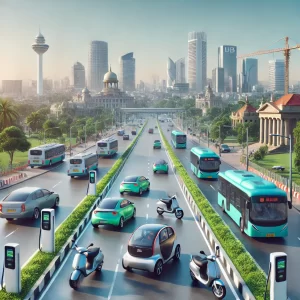Bangalore, often hailed as India’s Silicon Valley, is driving full speed ahead into the electric vehicle (EV) revolution. With a unique combination of technological innovation, environmental awareness, and a growing need to combat traffic and pollution, the city stands poised to become a model for sustainable urban transport. Let’s explore how electric vehicles are shaping the future of Bangalore.
The Rise of EVs in Bangalore
Bangalore’s EV journey is propelled by several factors: rising fuel prices, increasing environmental consciousness, and advancements in electric mobility technology. The city’s tech-savvy population and supportive government policies are accelerating this shift. The state government’s Karnataka Electric Vehicle and Energy Storage Policy, launched in 2017, was among the first in India to promote electric mobility, offering incentives for manufacturers and consumers alike.
From electric two-wheelers and buses to growing EV infrastructure, Bangalore is witnessing a transportation transformation. Brands like Ather Energy, Ola Electric, and Mahindra Electric — all with roots or significant operations in the city — are making EVs more accessible and attractive.
Government Initiatives and Infrastructure Development
The Karnataka government has rolled out multiple initiatives to fast-track EV adoption. Subsidies on electric vehicles, tax exemptions, and low registration fees are encouraging individuals and businesses to make the switch. Additionally, the government is focusing on expanding charging infrastructure, a crucial factor in easing range anxiety.
Bangalore now has hundreds of public charging stations, with more planned under partnerships between the government and private companies like BESCOM (Bangalore Electricity Supply Company). Fast-charging stations are being deployed along key routes, shopping malls, tech parks, and residential communities to ensure convenience for EV owners.
The city’s public transport sector is also embracing electric mobility. BMTC (Bangalore Metropolitan Transport Corporation) has introduced electric buses, reducing emissions and noise pollution while providing an eco-friendly alternative to diesel buses.
The Role of Startups and Tech Companies
Bangalore’s startup ecosystem is playing a pivotal role in advancing EV technology. Companies like Ather Energy are designing cutting-edge electric scooters, while Log9 Materials is working on faster-charging, longer-lasting batteries. Ola Electric, with its massive EV manufacturing plant, is redefining personal electric mobility with plans for electric scooters, cars, and even electric-powered ride-hailing services.
Software companies are contributing to the ecosystem too. Advanced telematics, navigation systems that include charging station maps, and battery analytics are improving the EV ownership experience. Companies like Sun Mobility are innovating battery-swapping technology, offering faster recharge alternatives that could reshape Bangalore’s EV infrastructure.
Challenges on the Road Ahead
While Bangalore is on the fast track to an electric future, challenges remain. High initial costs of EVs, limited range, and charging infrastructure gaps still deter many potential buyers. The power grid also needs upgrades to handle the increased load from EV charging stations, ensuring consistent and clean energy supply.
Battery disposal and recycling present another significant challenge. Sustainable practices in battery production, reuse, and recycling will be crucial to prevent environmental damage — an ironic pitfall in an otherwise green transition.
Traffic congestion is another pressing issue. Even with an increase in EVs, Bangalore’s roads remain crowded. To truly embrace sustainable transport, the city needs to complement EV adoption with better public transportation and last-mile connectivity solutions.
Future Prospects: What Lies Ahead?
The future looks bright for EVs in Bangalore. With more affordable models entering the market, increased investments, and expanding infrastructure, EV adoption is set to rise exponentially. Let’s take a look at key trends shaping the city’s EV landscape:
- Affordable EVs for the Masses: Major automakers like Tata, Hyundai, and Ola Electric are focusing on budget-friendly models, making EVs more accessible to middle-class families.
- Expanding Charging Network: Government and private sector partnerships are expected to scale up charging stations across the city, including fast-charging and battery-swapping solutions.
- Fleet Electrification: Bangalore’s booming food delivery and ride-hailing services — Swiggy, Zomato, Ola, Uber — are steadily shifting to electric fleets, incentivized by cost savings and environmental benefits.
- Renewable Energy Integration: To ensure a truly green future, the city is exploring ways to power charging stations with solar and other renewable energy sources, reducing reliance on fossil fuels.
- Autonomous and Connected EVs: Bangalore’s tech giants are investing in autonomous vehicle technology and smart transportation networks, hinting at a future where self-driving electric taxis and buses could become a reality.
- Battery Innovation: The city’s startups and research centers are pushing advancements in battery efficiency, charging speed, and sustainable materials — innovations that could reshape the global EV market.
Conclusion
Bangalore’s journey toward an electric vehicle future is both promising and inspiring. With the perfect blend of innovation, policy support, and citizen enthusiasm, the city is on track to becoming India’s electric mobility capital. While challenges like infrastructure gaps and affordability remain, the rapid pace of development suggests that Bangalore is ready to charge into a cleaner, greener, and smarter transportation era.
As more people embrace electric mobility, the roads of Bangalore may soon hum to the quiet, clean buzz of electric engines — a sign of progress and sustainable urban living. The future of electric vehicles in Bangalore isn’t just about transportation — it’s about transforming the city’s very landscape and lifestyle for generations to come.


